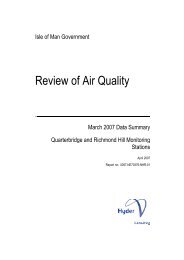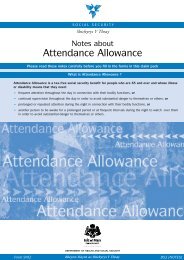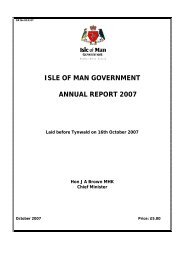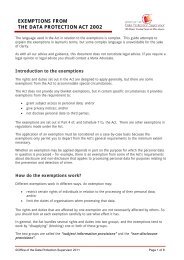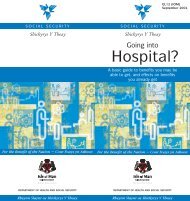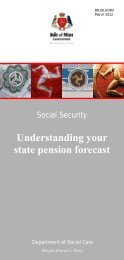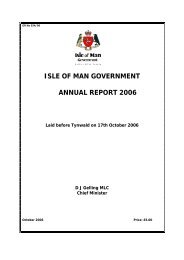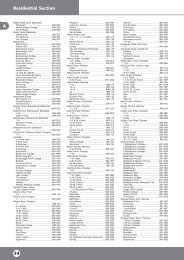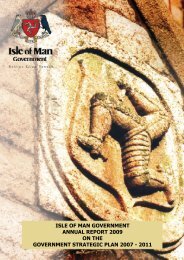Cowes of the North - Isle of Man Government
Cowes of the North - Isle of Man Government
Cowes of the North - Isle of Man Government
Create successful ePaper yourself
Turn your PDF publications into a flip-book with our unique Google optimized e-Paper software.
4.3.3 Employment Generation<br />
As discussed in Section 2.3 above, <strong>the</strong> schemes are expected to generate an additional 35<br />
full time equivalent direct jobs. In addition, <strong>the</strong>re would be employment creation in <strong>the</strong> wider<br />
economy as a result <strong>of</strong> multiplier effects.<br />
4.3.4 Direct Tax Benefits<br />
In <strong>the</strong> past, <strong>the</strong> <strong>Isle</strong> <strong>of</strong> <strong>Man</strong> has used expenditure to tax ratio <strong>of</strong> 1:0.11 for direct spending by<br />
visitors and 0.6 for fuel. For indirect spending, <strong>the</strong> tax ratio is 1:0.25. These are still<br />
considered to be appropriate by <strong>the</strong> <strong>Government</strong>.<br />
The fuel component has been estimated as a refuelling cost per visit <strong>of</strong> £25, which is<br />
incurred by visitors and events. Obviously as resident boat ownership increases, so will <strong>the</strong><br />
amount <strong>of</strong> fuel consumed, and this should probably also be taken into account.<br />
Tax revenue excluding VAT (see Section 4.3.5), from direct and indirect/induced spending on<br />
fuel and o<strong>the</strong>r goods and services would rise from £136,000 in 2007 to £1.2m in 2026.<br />
4.3.5 Revenue Sharing Benefits<br />
The <strong>Isle</strong> <strong>of</strong> <strong>Man</strong> has a new revenue sharing agreement with <strong>the</strong> UK that replaces <strong>the</strong><br />
Common Purse Agreement used for <strong>the</strong> collection and allocation <strong>of</strong> VAT. Under this<br />
agreement, instead <strong>of</strong> receiving a share <strong>of</strong> VAT, <strong>the</strong> <strong>Isle</strong> <strong>of</strong> <strong>Man</strong> <strong>Government</strong> receives<br />
revenue based on <strong>the</strong> contribution <strong>of</strong> an activity to <strong>the</strong> national income <strong>of</strong> <strong>the</strong> island. This is<br />
measured in terms <strong>of</strong> <strong>the</strong> salaries and generated pr<strong>of</strong>its that are retained on <strong>the</strong> island<br />
resulting from an activity. If pr<strong>of</strong>its are taken <strong>of</strong>f <strong>the</strong> island, <strong>the</strong>n <strong>the</strong>y do not count,<br />
The agreement came into effect recently, and it is too soon to say for certain what <strong>the</strong> impact<br />
will be. However, as rule <strong>of</strong> thumb, if an activity results in £0.25m <strong>of</strong> salaries and retained<br />
pr<strong>of</strong>its, it is expected to generate about £40,000 <strong>of</strong> customs revenues; a ratio <strong>of</strong> about 6:1.<br />
We have estimated <strong>the</strong> salaries generated by <strong>the</strong> marina developments by assuming that 35<br />
full time jobs are directly generated and a fur<strong>the</strong>r 30 are indirectly generated over <strong>the</strong> course<br />
<strong>of</strong> <strong>the</strong> developments, and that average salaries are £27,900 per annum. It is assumed that<br />
<strong>the</strong> additional employment is all <strong>of</strong> local people and that <strong>the</strong> salaries are <strong>the</strong>refore retained<br />
on <strong>the</strong> <strong>Isle</strong> <strong>of</strong> <strong>Man</strong>.<br />
We have estimated <strong>the</strong> pr<strong>of</strong>its generated by <strong>the</strong> marinas using a trading to pr<strong>of</strong>it ratio <strong>of</strong> 75%,<br />
although this will depend on <strong>the</strong> commercial model for development / operation. We have<br />
assumed that <strong>Isle</strong> <strong>of</strong> <strong>Man</strong> Harbours is <strong>the</strong> developer and operator, and that pr<strong>of</strong>its are fully<br />
retained on <strong>the</strong> <strong>Isle</strong> <strong>of</strong> <strong>Man</strong>. It is beyond <strong>the</strong> scope <strong>of</strong> this study to estimate <strong>the</strong> pr<strong>of</strong>its<br />
earned by o<strong>the</strong>r businesses directly or indirectly, thus we have retained <strong>the</strong> tax ratios<br />
described above as a proxy for <strong>the</strong> multiplier effects on taxation and revenue sharing. These<br />
ratios may now be on <strong>the</strong> high side.<br />
Although <strong>the</strong> benefits will ultimately be much <strong>the</strong> same whe<strong>the</strong>r <strong>the</strong> <strong>Government</strong> or a private<br />
sector company operates <strong>the</strong> marinas, in reality <strong>the</strong> impact on national income will be<br />
measured more quickly if it is <strong>the</strong> latter, as <strong>the</strong> <strong>Government</strong> does not boost national income<br />
directly. The options for who develops and operates <strong>the</strong> marinas and <strong>the</strong>ir impact on<br />
revenue sharing should be carefully investigated.<br />
The revenue share accruing from <strong>the</strong> new marinas is estimated to rise from £53,000 when<br />
<strong>the</strong> first new berths come into service, to £339,000 in 2026 with planned investments, and<br />
could reach £460,000 in 2026 if <strong>the</strong> additional potential berths are constructed<br />
31


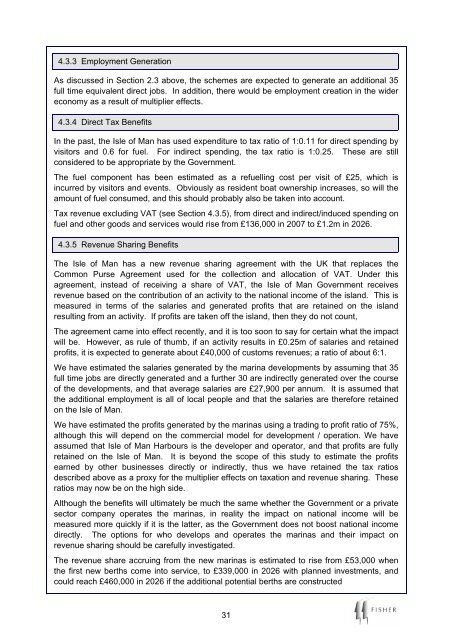
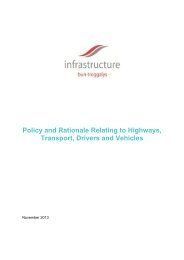
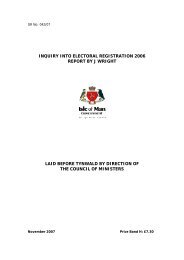
![Smeaton v Equifax CA[2013] EWCA Civ 108](https://img.yumpu.com/22052507/1/184x260/smeaton-v-equifax-ca2013-ewca-civ-108.jpg?quality=85)

